FCC Broadband Maps and the Challenge Process
The Federal Communications Commission (FCC) recently released a new National Broadband Map which displays where internet services are and are not available across the country, as reported by internet service providers. The map allows consumers and other stakeholders to easily dispute, or challenge, information shown on the map that they believe is inaccurate. To view the map, visit https://broadbandmap.fcc.gov/home.
The FCC is relying on you - individuals, local governments, tribal entities, and organizations, to review your location on the map and challenge the information if you believe it is inaccurate. Your participation in the challenge process helps build a more accurate map that will identify the locations most in need of high-speed broadband investments to help ensure they receive their fair share of government funding to assist in expanding internet access in these areas.
The FCC map will be used to calculate the funds allocated to the State of Minnesota by the National Telecommunications and Information Administration (NTIA) Broadband Equity, Access, and Deployment (BEAD) program. This program will provide over $42 billion in funding for broadband deployment nationwide under the Infrastructure Investment and Jobs Act (IIJA).
Carver County residents, businesses and organizations should submit a challenge if:
- A provider denied a request for service at your location,
- A provider does not offer the technology reported to be offered at your location,
- A provider does not offer the speeds reported to be available at your location,
- A provider needed to build new equipment at your location,
- A wireless or satellite signal is not available at your location,
- A provider failed to schedule a service installation within ten business days of a request,
- A provider did not install the service at the agreed-upon time, or
- A provider requested more than the standard installation fee to connect the service.
How to Submit Individual Challenges:
• First, look up your address on the map at https://broadbandmap.fcc.gov/.
o If you do not have an address, you can enter a town name and state, or select “Location” underneath the search bar. You can zoom on the map to find a particular location.
• Availability Challenge. If the information on the map about the available internet services is inaccurate, you can dispute it by clicking on the Availability Challenge link on the right side of the map and submitting the form. o You can base a challenge on several reasons, including that the provider denied a request for service, does not offer the reported speeds, demanded excessive fees, or failed to schedule a requested installation within 10 business days.
o Providers are expected to communicate and work directly with you to resolve challenges that they do not agree with. If a provider disputes a challenge, then the FCC will make the final decision. If decided in your favor, then the provider must update its information so that the map does not show the location as served.
• Location Challenge. If your location is missing or inaccurately reflected on the map, you may submit a Location Challenge to correct or add the location. The FCC will review and decide on your submission. o You can correct a location by clicking on the Location Challenge link to the right of the address on the map. o You can add a location by clicking on the place on the map where the location should be and then clicking the “Challenge Location” button.
• Mobile Challenge. If the information on mobile coverage is incorrect, you can dispute it by taking outdoor (or in-vehicle) speed tests on your mobile phone with the FCC’s Speed Test App.
The FCC Broadband Map is live and ongoing and updates/corrections should be submitted anytime they are found and are reviewed and corrections incorporated on a periodic basis.
The deadline to submit challenges to the map data that will be used to disburse the over $42 billion in Federal BEAD broadband funding, was January 13, 2023. The County initiated what are called bulk challenges to the "fabric data, which makes up the map" for roughly 350 missing locations not identified in the FCC Map. We also, based on our ongoing partnership with Metronet, reviewed Metronet data in the map and with Metronet's support, submitted a bulk challenge for roughly 300 locations that were showing incorrect Metronet service data that would preclude them from being eligible locations for any Federally funded grant options.

